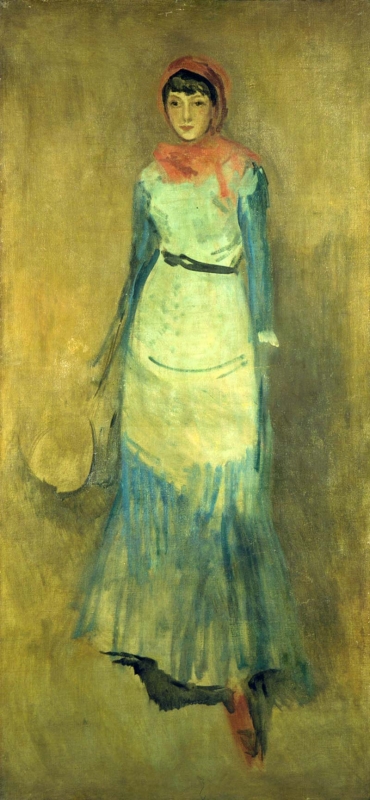Home > Catalogue > Browse > Harmony in Coral and Blue: Miss Finch << >>
Composition
The model's dress and pose in Harmony in Coral and Blue: Miss Finch is similar to that in a portrait of Maud Franklin (1857-1939), which was altered to become Portrait of Miss Florence Leyland [YMSM 107]. Perhaps the portrait of Millie formed part of the development of this composition.
To some extent the composition and colour scheme – the pale turquoise dress, with dark cobalt blue on the sleeves and streaked down the bottom of the skirt – resemble descriptions of Whistler's series of 'Blue Girls' (Annabel Lee [YMSM 079], The Blue Girl: Portrait of Miss Elinor Leyland [YMSM 111]. The Blue Girl: Maud Franklin [YMSM 112], Arrangement in Blue and Green [YMSM 193], The Blue Girl: Portrait of Connie Gilchrist [YMSM 207], and Scherzo in Blue: The Blue Girl [YMSM 226]).
Technique
The coarse plain-weave canvas was prepared with an off-white and possibly a mid-grey ground.
Whistler sketched the overall composition roughly in brown, giving the painting a warm tonality, which unifies the final colour composition. The 'coral' of the title is seen in her head-scarf and shoes. There are pentimenti: her shoulders were originally higher, and her hands have been rubbed out. Whistler applied the paint with thin strokes and washes of blue, red and pink tints, leaving some parts less finished than others.
Conservation History
The coarse plain-weave canvas is glue-lined onto a finer plain tabby weave canvas. The application of an extra canvas support at the back of the original using adhesive, and often heat and pressure, was normally performed to strengthen a damaged or fragile canvas, but here it may have been chosen by the artist to emphasise the canvas weave.
The paint layer has sustained some damage, with flaking and paint-loss. It is possible some abrasion dates back to Whistler's time. There are signs that the canvas has been torn and folded, resulting in areas of fractured paint and craquelure. It has been repaired at some time and there has been extensive retouching. The paint layer is fragile, although a thick layer of glossy varnish has partially preserved it. 1
Frame
Portrait Whistler frame, 203.3 x 101.7 x 6.6 cm. 2
Last updated: 4th December 2020 by Margaret







